Smooth Transitions: 5-Minute Wake-Up and Bedtime Yoga Practices

Waking up and preparing for sleep are arguably the most influential parts of our days, in the lens of holistic wellness. If we “wake up on the wrong side of the bed,” as the saying goes, our whole day can feel off. How we bring ourselves from sleep into full wakefulness can have significant impacts on the rest of our waking day. How we prepare ourselves for sleep is also meaningful in its effect on the quality of sleep itself.
If we don’t sleep well, our bodies, minds, and spirits will most likely not feel their best until we sleep again. If that happens night after night, we’ll find ourselves on “sleep debt,” a condition that can be a significant drain on our sense of subjective wellbeing and can even negatively impact our careers, social lives, close relationships, and physical health.
Can yoga help? How so? The practice can have almost immediate effects on body, mind, and spirit—effects that can be achieved through careful, purposeful sequencing. A quite important part of learning and growing within the practice is evolving in the ability to do just that, to shape and mold your practice to what is needed on any given day.
Waking up, it can help one ease to wake with calm, collected energy. In the ideal, that kind of energy can resonate all day long, until it is time for sleep again. When preparing to sleep, yoga practice can facilitate the transition of body, mind, and spirit into sleep, leading into a more wholly restful, rejuvenating sleep.
Practicing when waking up and before going to sleep can also become a ritual that leads to more consistent yoga practice; every day, we wake and go to sleep! Keeping these practices short can also make them feasible, thus immune from the “I don’t have time” impediment to practice. Let’s look at fast, easy yoga sequences for waking up and heading into sleep!
Waking Yoga Practice
Pranayama (Breathwork): 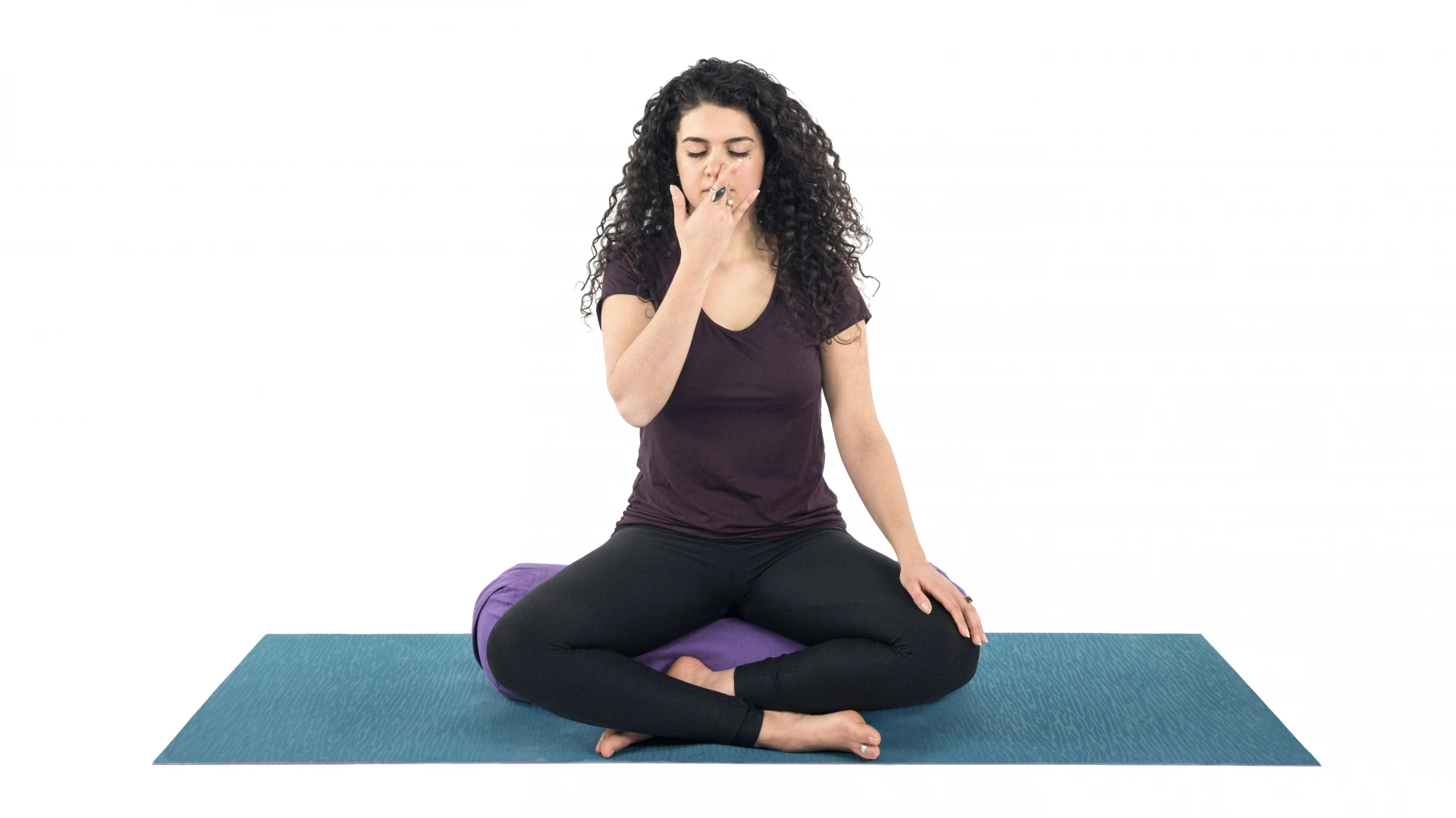
1. Take 10 to 15 rounds of breathing with a ratio of a longer inhalation to exhalation, which has an energizing effect.
2. Start with breathing in for a count of five and breathing out for a count of three.
3. If that feels comfortable, try a ratio of a six-count inhalation and a four-count exhalation.
4. After 10 to 15 rounds, breathe normally and notice how you feel.
Asana (Posture) 1:
1. Sit in Sukhasana (Easy Pose), ankles crossed and torso rising directly out of your hips, like a tree growing straight up out of its roots.
2. Palpate (rub) your frontal hip bones (bony protuberances just a bit lower than your belly button). If you feel them dipping backward, sit on a pillow or a folded blanket.
3. Then interlace your fingers and push your palms away from you, holding for three to five full breaths, for a very nice hand stretch.
4. Let that release and take a few circles each way with your wrists.
5. Then gently, but expansively shake out your hands and wrists.
Asana 2:
1. Remaining in Easy Pose, take a Marjarasana/Bitilasana (Seated Cat/Cow Pose) flow. (pictured below) 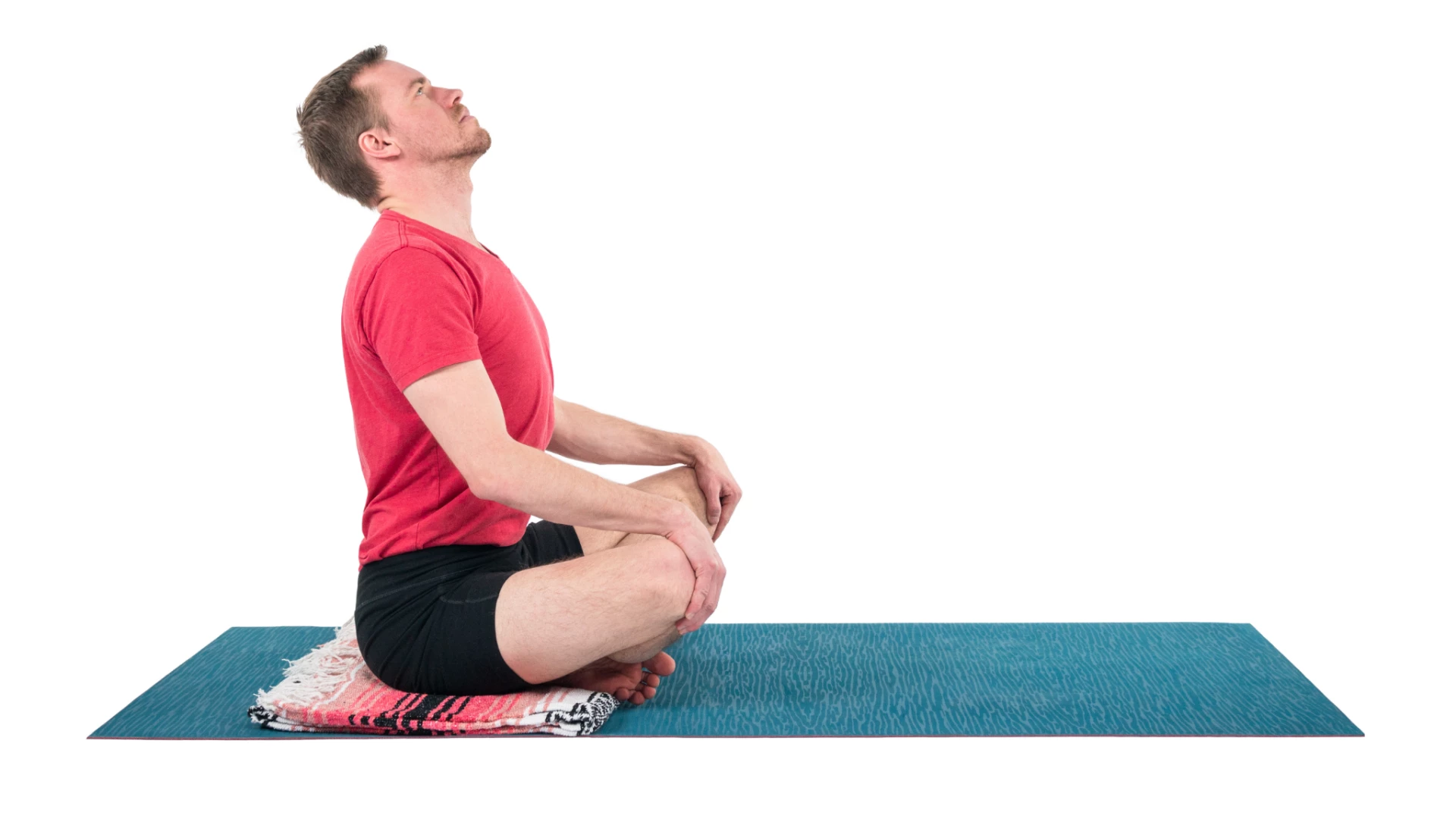
2. Start by lifting your heart to the sky and looking upward. Only allow your head to go as far back as feels comfortable on your neck. Remain mindful that your spine, which includes your neck—and your whole body, for that matter—is not fully warmed up, as you just woke up.
3. Take 7 to 10 rounds.
4. Breathe here and notice the echo of movement throughout your body.
Dhyana (Meditation) in Visualization:
1. Breathe naturally. If it feels comfortable for you, close your eyes. If it’s not comfortable, gaze softly forward.
2. Set an intention for your day. It can be practical to accomplish a particular set of tasks with patience. It can be more spiritual and subjective, such as to feel confident in your power or to spread joyful light to all whom you encounter.
3. Visualize yourself fulfilling this intention.
4. When you are ready, blink your eyes open (if you had them closed), and find a small smile at the corners of your lips.
5. Continue with your morning as you are ready.
Yoga Practice to Prepare for Sleep
Pranayama (Breathwork):
1. Take 10 to 15 rounds of breath with a ratio of a longer exhalation to inhalation. Doing so has a calming, “down-shifting” effect.
2. Start with breathing in for a count of three and breathing out for a count of five. If that seems accessible, try a ratio of a four-count of inhaling and a six-count of exhaling.
3. After 10 to 15 rounds, breathe normally and observe how you feel.
Asana (Posture) 1: 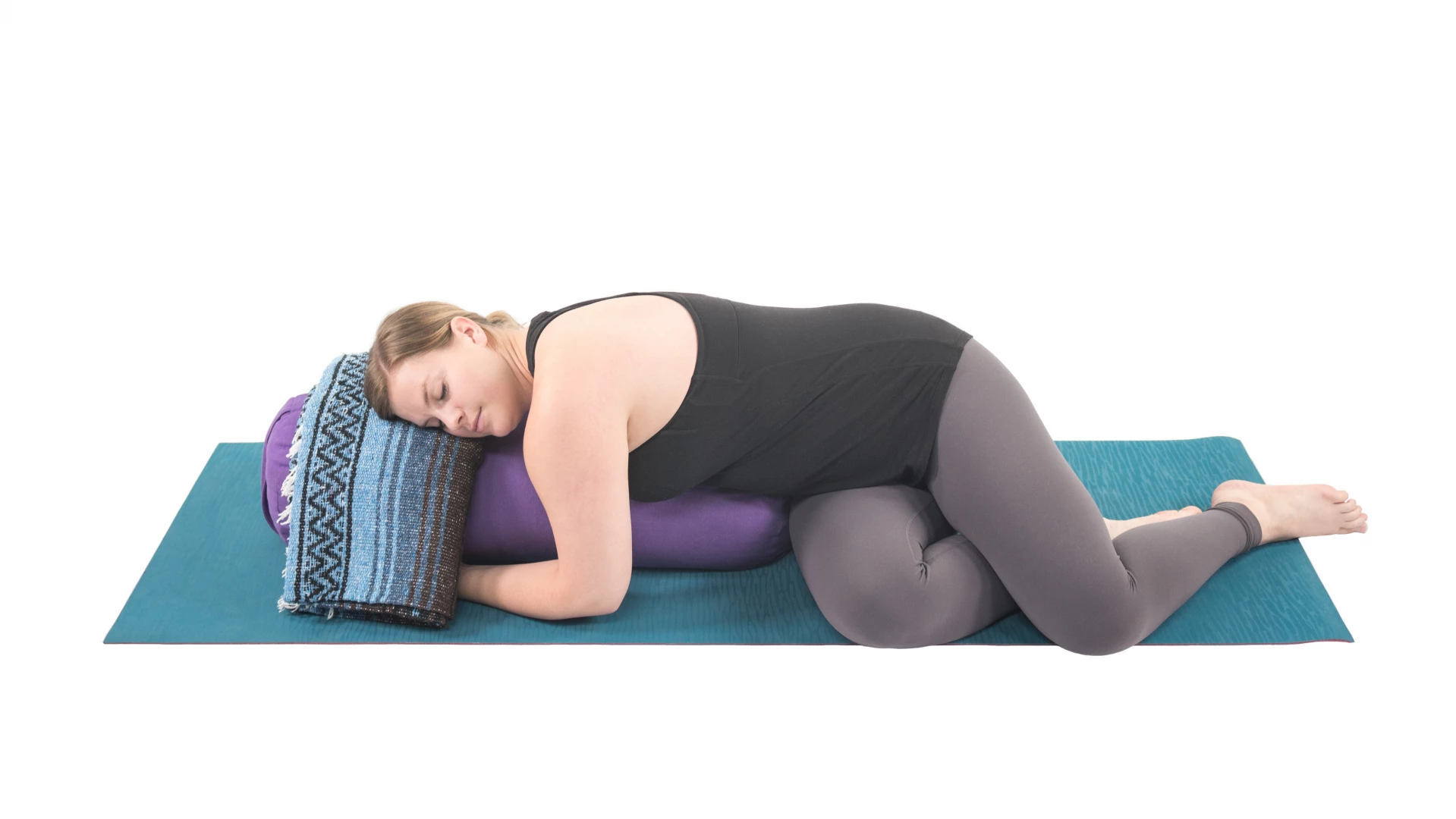
1. Lie on your back with your knees bent and the soles of your feet on the floor. Extend your arms straight out from your shoulders.
2. Press into your feet just enough to pick your hips up slightly and move them a few inches left. Set your hips back down onto the floor.
3. Let your knees fall to the right. If you feel any strain on the hip, thigh or knee of your top (right) leg, place a pillow or folded blanket in between your thighs. (variation with additional props pictured above)
4. Breathe here in this restful twist for 5 to 10 breaths.
5. Notice any areas of tension, inhaling nourishment into them while allowing the exhalation to take away what doesn’t serve you.
6. Then bring your knees up, push into your feet to move your hips toward the right, and let your knees fall to the left.
7. Take the twist to this side for 5 to 10 more breaths.
Asana 2: 
1. Move toward a wall (coming off your bed if it’s not against a wall), and place a pillow or folded blanket against it.
2. Sit sideways on the pillow or blanket, taking one hip right up against the wall. Then, simultaneously lay your back down while you take your legs up against the wall.
3. Observe any areas of tension, without judging them.
4. Inhale nourishment into those areas, and let the exhalation take away what you don’t need.
5. Stay here for 10 to 20 breaths.
Dhyana (Meditation) in Visualization: 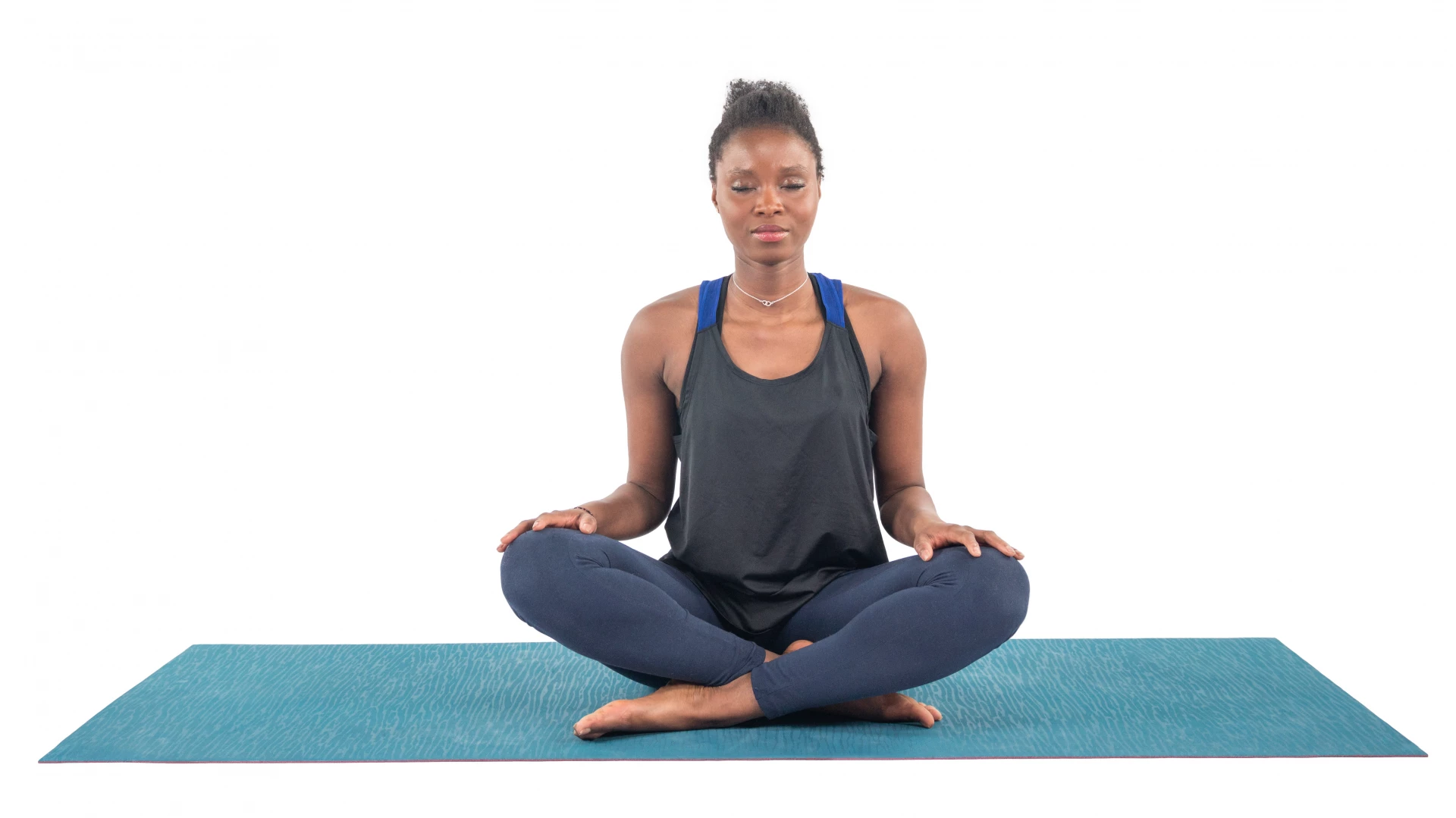
1. Breathe normally. If it feels comfortable for you, close your eyes. If it’s not comfortable, gaze softly forward.
2. Picture a color that makes you feel calm and restful. Imagine a ball of this color at your heart center.
3. Let the ball begin to grow larger, so that it moves through your chest, back, and belly. It then moves through your arms, legs, and neck, and then finally, your fingers, toes, and head. As the color moves through your body, it seeps into your every cell.
4. Take ten breaths with this color radiating throughout you.
5. When you are ready, blink your eyes open (if you had them closed), and notice yourself with a small smile.
6. Allow your head to hit your pillow, and yourself to settle into sleep, as you’re ready.
Click here for more yoga practice tips from YogaUOnline and Kathryn Boland:
4 Ways To Fit Yoga Into Your Day – No Leggings Required.
Yoga For Every Body: How To Adapt Poses For Different Situations And Conditions And Purposes– study this course from YogaUOnline and Olga Kabel.
Also, read...
15 Natural Remedies For A Good Night’s Sleep
Exploring the Link Between Sleep and Anxiety
Yogic Breathing for Better Sleep – Balancing Apana and Prana Vayus
Related courses
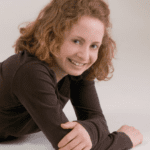
Kathryn Boland is an RCYT and R-DMT (Registered Dance/Movement Therapist). She is originally from Rhode Island, attended The George Washington University (Washington, DC) for an undergraduate degree in Dance (where she first encountered yoga), and Lesley University for an MA in Clinical Mental Health Counseling, Expressive Therapies: Dance/Movement Therapy. She has taught yoga to diverse populations in varied locations. As a dancer, she has always loved to keep moving and flowing in practicing more active Vinyasa-style forms. Her interests have recently evolved to include Yin and therapeutic yoga, and aligning those forms with Laban Movement Analysis to serve the needs of various groups (such as Alzheimer’s Disease patients, children diagnosed with ADHD, PTSD-afflicted veterans – all of which are demographically expanding). She believes in finding the opportunity within every adversity, and doing all that she can to help others live with a bit more breath and flow!



